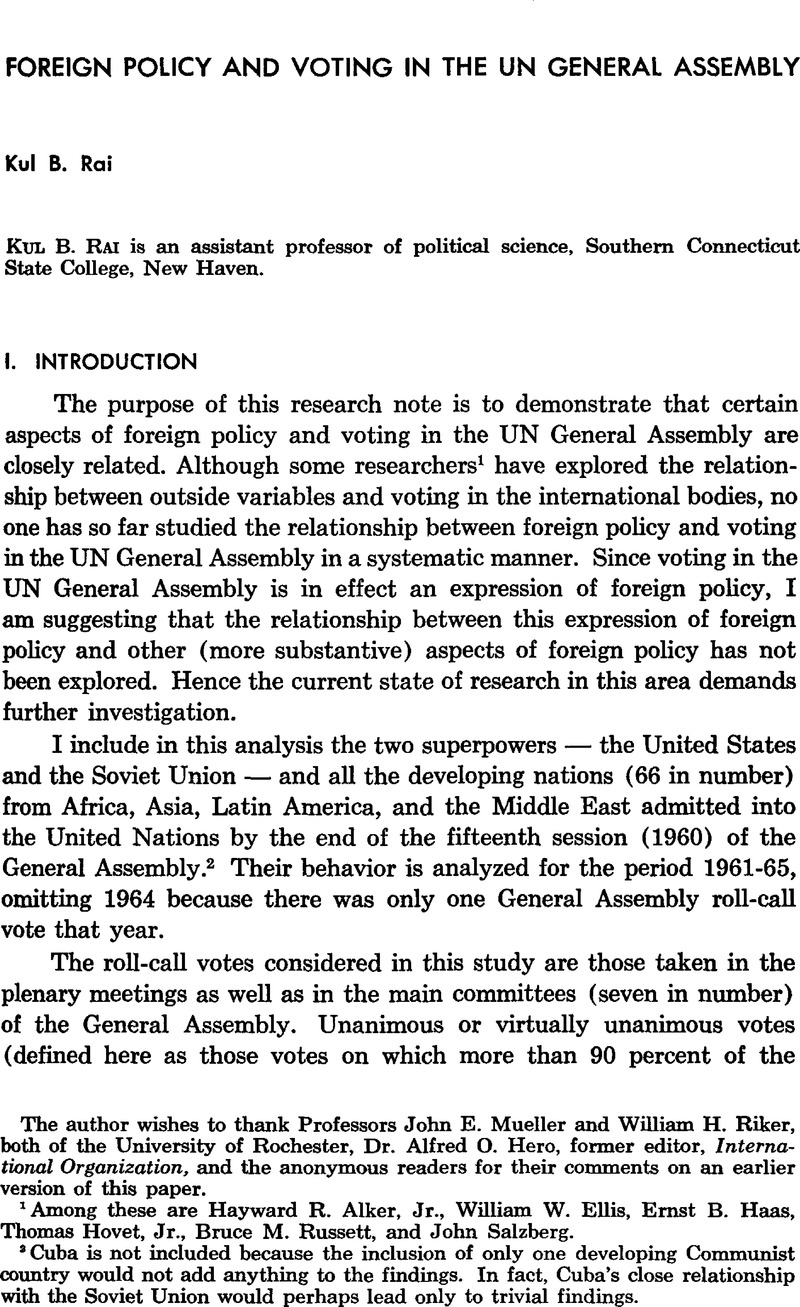Article contents
Foreign Policy and Voting in the UN General Assembly
Published online by Cambridge University Press: 22 May 2009
Abstract

- Type
- Note on Theory and Method
- Information
- Copyright
- Copyright © The IO Foundation 1972
References
1 Among these are Hayward R. Alker, Jr., William W. Ellis, Ernst B. Haas, Thomas Hovet, Jr., Bruce M. Russett, and John Salzberg.
2 Cuba is not included because the inclusion of only one developing Communist country would not add anything to the findings. In fact, Cuba's close relationship with the Soviet Union would perhaps lead only to trivial findings.
3 The exclusion of unanimous or virtually unanimous votes leaves us with 170, 118, 66, and 110 votes in 1961, 1962, 1963, and 1965, respectively. These votes were taken on five principal categories: political, colonial, human rights, economic and social, and administrative and budget.
4 This index varies between 0 and 100 percent. See Lijphart, Arend, “The Analysis of Bloc Voting in the General Assembly: A Critique and a Proposal,” American Political Science Review, 57 (12, 1963), pp. 902–917.CrossRefGoogle Scholar I consider the Index of Agreement a more reliable measure than Pearson's r for analyzing voting in the UN. See Rai, Kul B., “The Relationship between Foreign Policy Indicators and Voting Patterns in the UN General Assembly” (Ph.D. Dissertation, University of Rochester, 1969), pp. 40–45.Google Scholar
5 The condition of being a former colonial power was also excluded from the analysis because neither of the two superpowers was, in fact, a colonial power.
6 The independent variables in the regression equations in these subfiles are: alliance with the United States (no country in the study is in alliance with the Soviet Union), United States military aid, Soviet military aid, United States economic aid per capita, Soviet economic aid per capita, trade with the United States, trade with the Soviet Union (the variables on trade measure the percentage of a country's total trade in a certain year with the United States or the Soviet Union as the case may be), Communist party membership as percentage of the working-age (15–64) population (to measure ideology), per capita gross domestic product (to measure economic situation; the data on per capita gross national product, which is a more familiar measure, are not available for different years for the countries under study), former colonial status, and anti-United States demonstrations (no anti-Soviet demonstrations in the countries under study are reported in the New York Times in 1962, 1963, and 1965 and very few anti-Soviet demonstrations are reported in 1961). Of these variables the following are used as dummy variables: alliance with the United States, Soviet military aid (because of the non-availability of the exact figures), and former colonial status. Also, the first subfile does not include any of these three variables, since all the Latin American countries under study are members of OAS, none of them received Soviet military aid during 1961–65, and none of them is a former colony (since the end of the first World War).
7 Besides the Latin American countries, the allies of the United States in the study are Nationalist China (especially because of the mutual security pact signed in 1954 and 1955), Iran, Pakistan, Philippines, Thailand, and Turkey.
- 23
- Cited by




